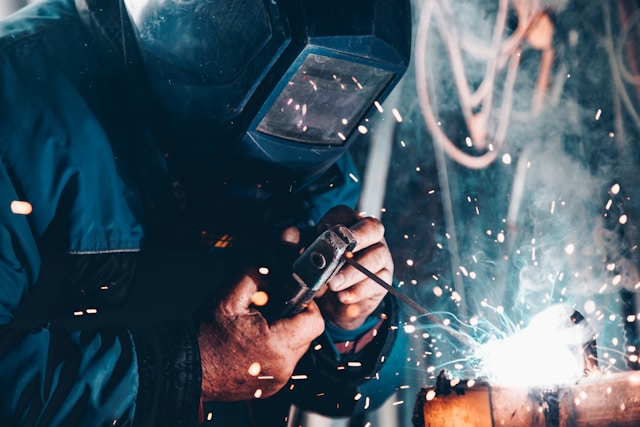Welding is a foundational skill in manufacturing and construction, evolving continuously over centuries. For welders, engineers, and tech enthusiasts, staying updated on the latest welding innovations is crucial and exciting. This blog post examines the advancements transforming welding and their implications for various sectors.
The Current State of Welding Technology
Today, welding technology is characterized by its versatility and adaptability. From traditional methods to state-of-the-art innovations, welding remains at the forefront of industrial fabrication. One of the most significant advancements in recent years is the development of high-strength steels and alloys. These materials enable the creation of lighter, more fuel-efficient structures without compromising safety or durability.
Another key advancement is the use of digital technology to enhance precision and efficiency in welding. Computer-controlled welding machines allow for highly accurate welds, reducing waste and improving consistency. This is particularly valuable in industries where precision is paramount, such as aerospace and medical device manufacturing.
With the integration of AI in welding technology, the industry is experiencing a shift towards greater automation and efficiency. AI-powered systems can predict material behavior and optimize welding parameters in real-time, leading to improved quality and reduced defects. This is transforming the way welders approach their craft, opening up new possibilities for innovation and creativity.
Innovations Driving Change in Welding
Laser Welding
One of the most exciting developments in welding technology is the use of lasers. Laser welding offers several advantages over traditional methods, including increased speed, precision, and flexibility. By focusing a high-energy laser beam on a small area, materials can be fused with minimal heat input, reducing the risk of distortion.
Laser welding is particularly well-suited for applications requiring intricate detail and high strength, such as the production of medical devices and electronics. It also allows for the joining of dissimilar materials, which is a significant advantage in industries like automotive manufacturing, where lightweight materials are increasingly being used to improve fuel efficiency.
3D Printing and Welding
The fusion of 3D printing and welding technology is another groundbreaking innovation. By combining these two processes, manufacturers can create complex structures that would be difficult or impossible to achieve using traditional methods. Additive manufacturing, as it is known, allows for the creation of components with intricate geometries and internal structures, providing unparalleled design freedom.
This technology is already being used in the aerospace industry to produce lightweight, high-strength components. It also has the potential to revolutionize the production of custom parts and prototypes, reducing lead times and costs while increasing flexibility and innovation.
Automation and AI in Welding
Automation is not new to welding, but recent advances in AI-driven robotics are taking it to new heights. Automated welding systems equipped with AI can learn and adapt to different welding scenarios, optimizing parameters to achieve the best results. This reduces the need for manual intervention and allows for continuous operation, improving productivity and consistency.
These systems are particularly valuable in high-volume production environments, where time and precision are critical. The integration of AI also enhances safety by reducing the need for human operators to work in hazardous environments, minimizing the risk of accidents and injuries.
Impact of Innovations on Industries
Automotive Industry
In the automotive sector, innovations in welding technology are playing a crucial role in the development of more fuel-efficient vehicles. The use of high-strength steel and lightweight materials, combined with advanced welding techniques, allows manufacturers to produce vehicles that are both lighter and stronger.
Laser welding and automation are also enhancing production efficiency and quality control, enabling the production of complex structures with greater precision. This is particularly important as automakers strive to meet stringent emissions standards and consumer demands for safer, more efficient vehicles.
Aerospace Industry
In aerospace, welding innovations are driving the development of lighter, more efficient aircraft. Additive manufacturing and laser welding, alongside precision machining services, are being used to produce components with complex geometries that were previously unattainable. These technologies not only reduce weight but also improve performance and fuel efficiency.
The ability to join dissimilar materials is also a significant advantage in aerospace, where materials such as titanium and aluminum are commonly used. By enabling the production of hybrid structures, welding advancements are opening new avenues for innovation and design.
Construction Industry
Building on these innovations, the construction industry is seeing improvements in both the strength and durability of structures. Advanced welding techniques allow for the use of high-strength steels and alloys, which can withstand greater loads and environmental stresses.
Automation and AI are also enhancing safety and efficiency on construction sites. Robotic welding systems can perform repetitive tasks with precision and consistency, reducing the need for manual labor and improving overall productivity. This is particularly valuable in large-scale projects where time and accuracy are critical.
Forecasting Future Trends in Welding
The future of welding technology holds immense promise for continued innovation and advancement. One area of significant potential is the further integration of AI and machine learning in welding processes. By harnessing the power of data, AI systems can predict and optimize welding parameters in real-time, improving quality and efficiency.
Another emerging trend is the development of new materials and alloys designed specifically for welding applications. These materials offer unique properties that can enhance the performance and durability of welded structures, opening new possibilities for design and engineering.
Sustainability is also becoming an increasingly important consideration in welding technology. Efforts to reduce waste and energy consumption are driving the development of more environmentally friendly processes and materials. This is essential in meeting the growing demand for sustainable manufacturing practices and addressing global environmental challenges.
Conclusion
Now that we have explored the impact of welding innovations on various industries and glimpsed into the future of this technology, it is evident that welding will continue to play a critical role in shaping our world. From the production of complex structures and components to enhancing safety and efficiency, welding advancements are driving progress in multiple sectors.
